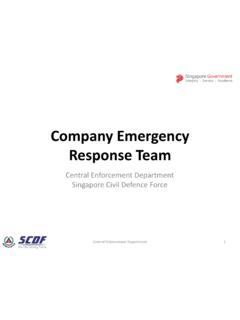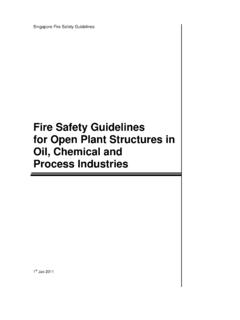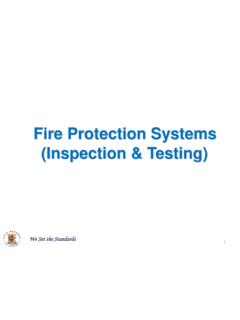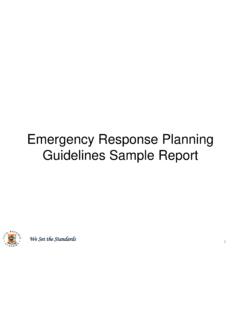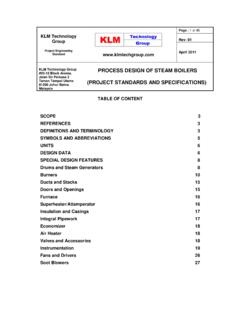Transcription of CHAPTER 7 MECHANICAL VENTILATION AND SMOKE …
1 1 CHAPTER 7 MECHANICAL VENTILATION AND SMOKE CONTROL SYSTEMS air conditioning & MECHANICAL VENTILATION SYSTEMS General (a) Where air- conditioning system is provided in lieu of MECHANICAL VENTILATION system during emergency, all the requirements specified in this Code for the MECHANICAL VENTILATION system shall apply to the air- conditioning system. (No illustration) The term air conditioning has been defined by the American Society of Heating, Refrigerating, and air conditioning Engineers as.
2 air conditioning is the process of treating air so as to control simultaneously its temperature, humidity, cleanliness and distribution to meet the requirements of the conditioned space The use of air conditioning and MECHANICAL VENTILATION systems will invariably, except for self-contained units, involve some use of pipe works for refrigerant/water circulation and ducts for air distribution and extraction. The use of ducts present the inherent possibility of spreading fire, heat, gases and SMOKE throughout the building or the floors/areas served.
3 Where air conditioning system is designed to operate during fire emergency, it is to be emphasized that the system shall comply with all the relevant requirements for the MECHANICAL VENTILATION system in this Code. (b) Ducts for air- conditioning and MECHANICAL VENTILATION systems shall be constructed in compliance with the following requirements: (i) All air- conditioning or other VENTILATION ducts including framing thereof, shall be constructed of steel, aluminium, glass-fibre batt or mineral-wool batt or other approved material.
4 (ii) All air- conditioning or other VENTILATION ducts shall be adequately supported. (iii) duct covering and lining should be non-combustible. However, if it is necessary to use combustible material, it shall:- 2 * when tested in accordance with methods specified in this Code, have a surface flame spread rating of not lower than Class 1, but in areas of building where Class 0 flame spreading rating is required for the ceiling construction under this Code, a Class 0 rating for the covering and lining materials shall be required; * when involved in fire generate a minimum amount of SMOKE and toxic gases.
5 And * be at least away from a fire damper. (iv) Materials and installation of all flexible joints and connections shall be in accordance with SS CP 13 Code of Practice for MECHANICAL VENTILATION and Air- conditioning in Buildings. Diagram (b) Minimum Class1 for insulation material/barrier lining and adhesives. Where ceiling construction requires class 0, covering and lining insulation material shall also be class 0.
6 Where combustible material is used for the insulation of the duct , it shall be kept at least 1000mm away from a fire damper in order to prevent premature closing of the damper arising from a fire from the combustible insulation material. For flexible joints and connections which are combustible, there is a need to limit the length of the joints and connection to max. 250mm and 400mm respectively. Please see clause in Volume 1 for illustration. (c) Pipework insulation Insulation for pipework associated with the air- conditioning and MECHANICAL VENTILATION systems shall comply with the following requirements.
7 (i) Insulation material for pipework together with vapour barrier lining and adhesives shall when tested in accordance with the methods specified in this Code, have a surface flame spread of not lower than Class 1 but in areas of buildings where Class 0 flame spread is required for the ceiling construction under this Code, a Class 0 rating for the insulation material shall be required. (ii) Notwithstanding the requirements of sub-clause (c)(i), the use of plastic and foam rubber insulation materials of a lower classification may be permissible if: * the material is the self-extinguishing type to the satisfaction of the Relevant Authority; * the insulation material is covered by or encased in a metal sheath or hybrid plaster or other non-combustible cladding materials acceptable to the Relevant Authority.
8 Provided that any opening in the element of structure or other part of a building penetrated by the pipework shall be effectively fire-stopped by replacement of the insulation material at the junction of penetration with fire resistant material having equal fire rating. Fire rated proprietary pipework system may be used if it is tested in the manner acceptable to the Relevant Authority. 4 Diagram (c) 1 Diagram (c) - 2 5 Diagram (c) - 3 Minimum class 1 for insulation material/barrier lining and adhesives.
9 Where ceiling construction requires class 0, insulation material shall also be class 0. However, the use of 10mm to 15mm maximum diameter pipe works for split unit system would be considered as acceptable. The use of fire collar shall be appropriate for the diameter of the PVC/UPVC pipe and shall be duly secured to the surface of the wall or floor with steel anchor bolts. (d) duct enclosure Enclosure of ducts shall comply with the requirements in sub-clause (a).
10 (No illustration) A protected shaft used for the enclosure of services shall comply with the following: (a) The protecting structure for protected shaft containing kitchen exhaust duct and MECHANICAL VENTILATION ducts serving areas specified in Cl. (g)(i) to (iii) and (h) which pass through one or more floors shall be masonry. Such shaft shall be completely compartmented from the rest of the shaft space containing other ducts or any other services installations.
